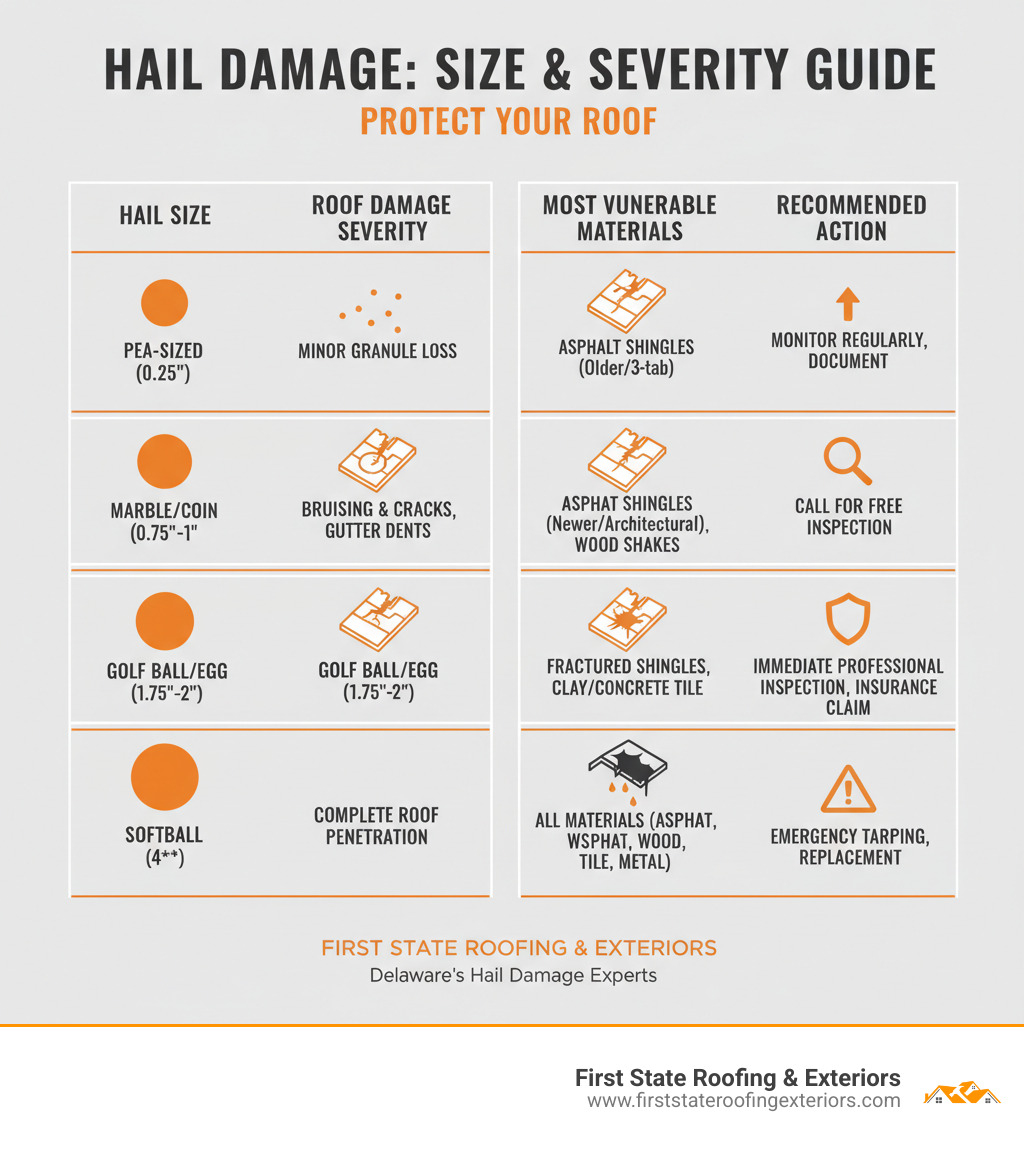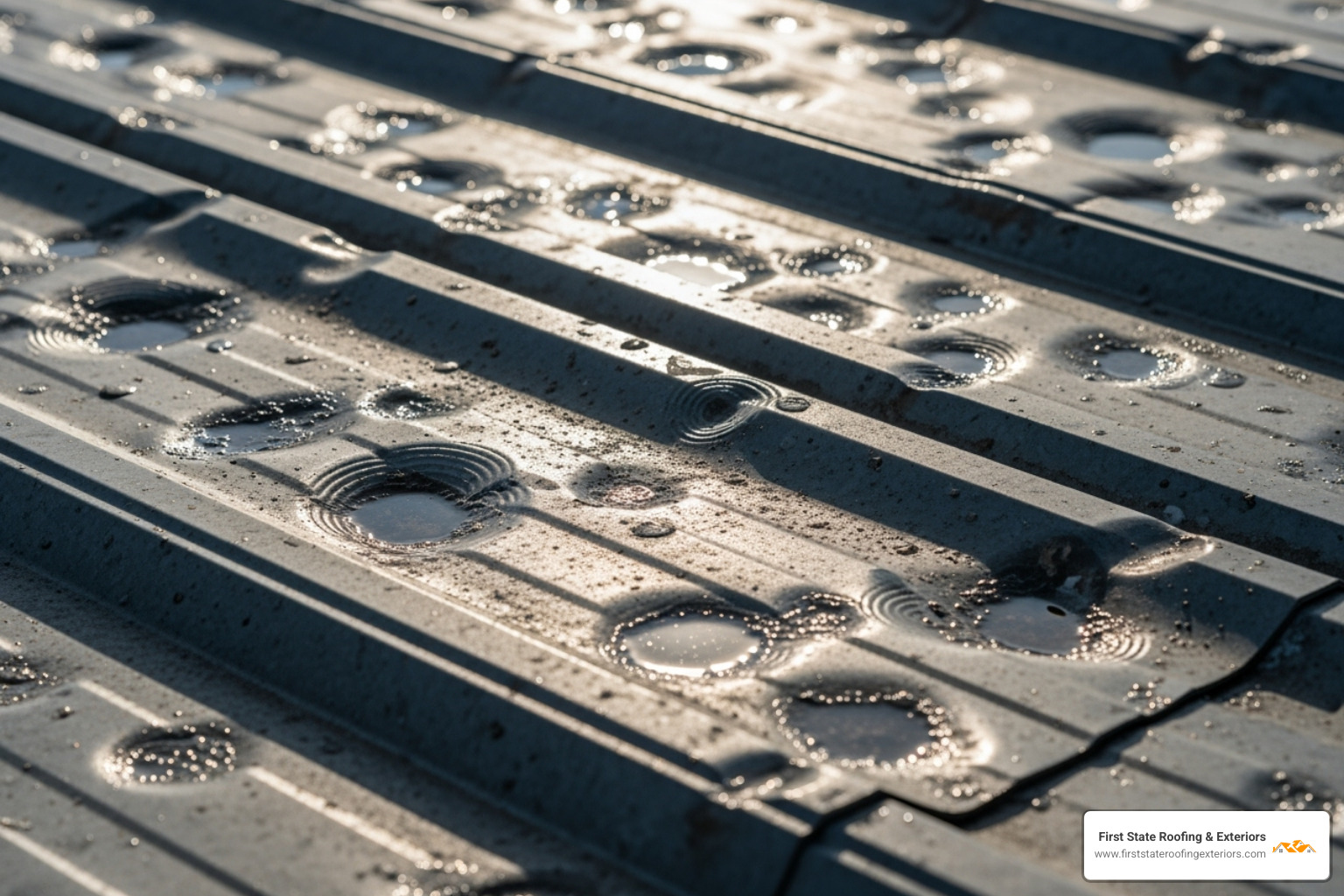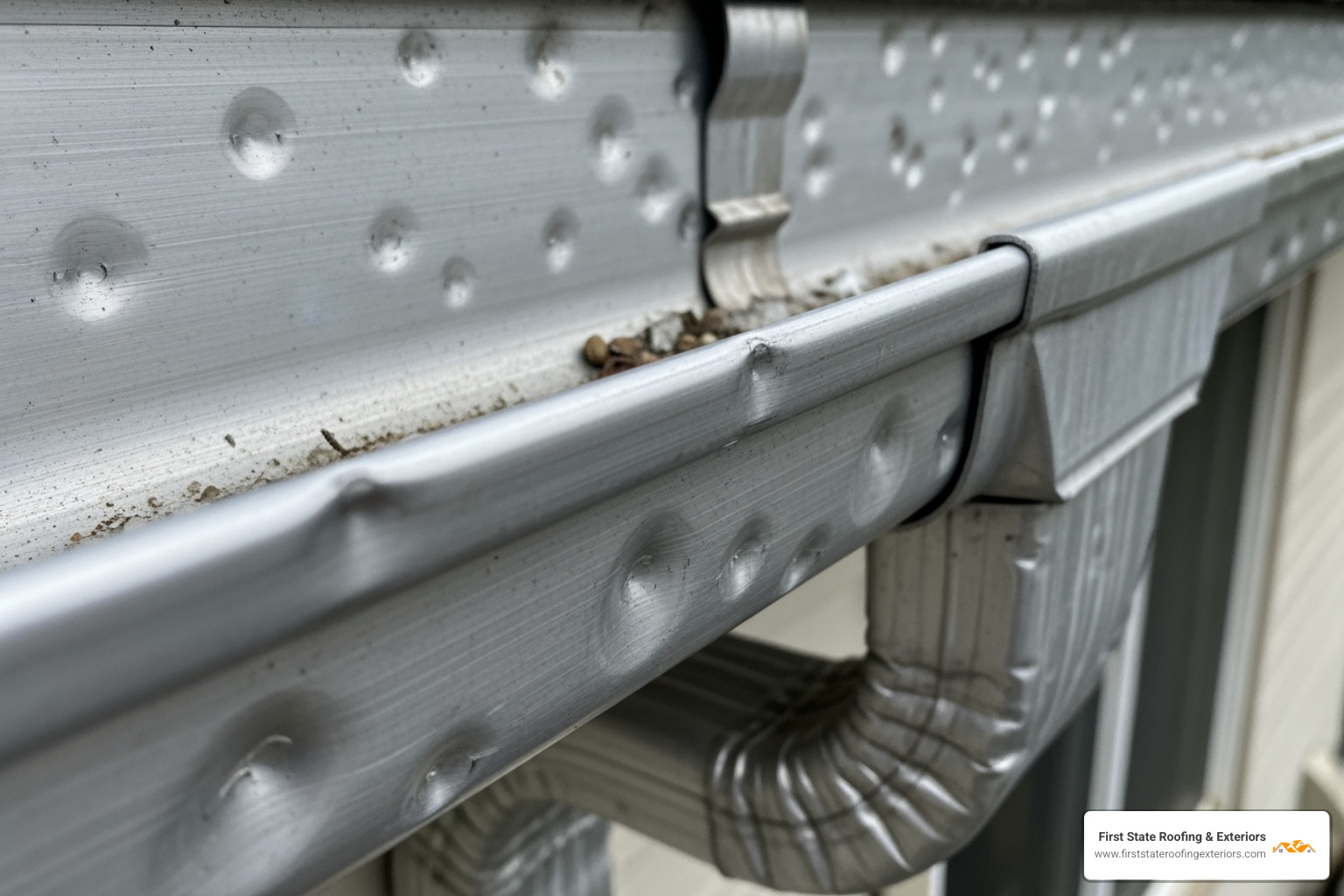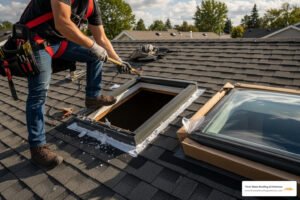Why Every Delaware Homeowner Needs to Understand Roof Hail Damage
Roof hail damage is a significant threat to your home’s structural integrity, causing over $1 billion in property damage annually across the U.S. While some impacts like dented gutters are obvious, much of the destruction remains hidden until water starts seeping into your home, making a professional assessment from Delaware’s trusted local experts essential.
Quick Answer: Key Signs of Roof Hail Damage
- Asphalt Shingles: Missing granules (bald spots), bruising, cracks, or exposed fiberglass.
- Metal Roofs: Dents, scratches, or chipped protective coating.
- Tile/Slate: Chipped edges, cracks, or shattered sections.
- Wood Shakes: Splits along the grain, deep gouges, or missing pieces.
- Collateral Clues: Dented gutters, damaged siding, chipped paint, or holes in window screens.
Hailstones measuring 1 to 1.25 inches in diameter are large enough to warrant an insurance claim for standard asphalt shingles. However, wind speed is a critical factor, as hailstones can reach speeds of 120 mph, dramatically increasing their destructive force. The danger lies in the timeline; damage worsens over time as small cracks expand and granule loss accelerates aging. This hidden damage can evolve into major structural problems, and most insurance policies require claims to be filed within six to 24 months.
The financial stakes are high. A professional roof inspection costs between $75 and $800, while repairs average $940 but can exceed $9,000 for a full replacement. Catching damage early often means the difference between a covered insurance claim and a major out-of-pocket expense. This guide will help you identify damage, steer insurance, and decide between repair and replacement.
If you suspect hail damage, don’t wait. We offer free estimates—call (302) 222-4065 to schedule your free professional inspection today.

Roof hail damage definitions:
How to Identify Hail Damage on Your Property
After a storm, a careful visual assessment from the ground can reveal clues about potential roof hail damage. This helps you decide if it’s time to call for a detailed roof inspection. Safety comes first: never climb onto a wet or steep roof. Leave up-close inspections to professionals who use proper safety equipment.
What Size Hail Causes Damage?
The most common question is how big hail needs to be to cause damage. The baseline is 1 to 1.25 inches in diameter (quarter-sized), which is large enough to damage standard asphalt shingles and warrant an insurance claim.
However, several factors influence the severity:
- Wind Speed: Strong winds can propel hailstones up to 120 mph, turning even small hail into damaging projectiles. The National Severe Storms Laboratory explains that hail forms in powerful thunderstorm updrafts, growing in layers until gravity pulls them down.
- Roof Material: Standard asphalt shingles are more vulnerable than impact-resistant (Class 3 or 4) options, which can often withstand hail up to 1.75 to 2 inches in diameter. A Class 4 rating is the highest, tested to withstand a 2-inch steel ball dropped from 20 feet.
- Roof Age: An older, brittle roof is more susceptible to damage than a new one. Years of UV exposure weaken shingles, making them more likely to crack or lose granules.
- Roof Slope: A steep slope may deflect some impacts, but a low-slope roof can take the full force of a perpendicular hit.
What Does Roof Hail Damage Look Like on Different Materials?
Knowing the signs of roof hail damage is key to a proper assessment.
Asphalt Shingles: This is the most common roofing material. Look for:
- Granule Loss: Hail strikes dislodge protective granules, leaving dark “bald spots.” Check your gutters for an accumulation of these sand-like granules.
- Bruising: Impacts can create soft, spongy spots on the shingle that compromise its integrity.
- Cracks: Visible fractures that expose the underlying layers to moisture.
- Exposed Fiberglass Mat: Severe impacts can puncture the shingle entirely.
Metal Roofs: While durable, they can show dents and dings. More serious is a chipped or scratched protective coating, which can lead to rust. In rare cases, large hail can cause punctures.

Wood Shakes: Damage appears as splitting along the grain, deep gouges, or missing sections broken off by the storm.
Tile Roofs (Clay/Concrete): These brittle materials can have chipped or cracked tiles. Large hailstones may shatter tiles completely or dislodge them, creating gaps.

Spotting Collateral Damage: Clues from the Ground
Often, the clearest evidence of a damaging hailstorm is at eye level. Check these areas for a quick, safe assessment:
- Gutters and Downspouts: Dents and dings on these soft metal components are a reliable indicator of hail intensity.
- Siding and Paint: Look for circular dents, cracks, or punctures on vinyl or aluminum siding, and chipped paint on windowsills or fascia boards.
- AC Units and Mailboxes: The delicate fins on outdoor AC units bend easily, and metal mailboxes will show obvious dents.
- Vehicles and Screens: Cars parked outside will display dents, and window screens may have tears or holes.
- Landscaping: Shredded leaves on plants and dents on deck surfaces also point to a significant storm.
If you spot damage in multiple areas, it’s time for a thorough roof evaluation. We offer free estimates—call (302) 222-4065 for a free inspection to document everything for a successful claim.

The Consequences and Costs of Roof Hail Damage
Ignoring what seems like minor cosmetic damage after a hailstorm is a costly mistake. Our experience serving Delaware communities, from the streets of Dover to coastal towns like Lewes, has shown that timely intervention is crucial to prevent escalating problems.
Can Hail Damage Cause Roof Leaks?
Roof hail damage rarely causes an immediate leak. The real danger is the slow, progressive failure it initiates. When hail strips protective granules from shingles, it exposes the asphalt to UV rays, accelerating deterioration. Bruises and cracks allow water to seep beneath the surface, compromising the underlayment and roof deck.
This water infiltration can lead to a domino effect:
- Structural Decay: Moisture rots the wooden components of your roof system, including the deck and rafters.
- Mold and Mildew: A damp attic becomes a breeding ground for mold, posing serious respiratory health risks.
- Reduced Insulation: Wet insulation loses its effectiveness, causing energy bills to spike.
- Interior Damage: Eventually, you’ll see ceiling stains, peeling paint, and sagging drywall.
A leak may not appear for weeks or even months after the storm, often triggered by subsequent rain or wind. This delayed timeline is why a prompt professional inspection is critical, even if your home appears fine.
How Much Does Repairing Roof Hail Damage Cost?
The cost to fix roof hail damage varies widely. A professional inspection typically runs from $75 to $800, an investment that provides a clear understanding of the damage for insurance purposes.
Repair costs depend on the severity of the damage. Minor fixes, like replacing a few shingles, might cost under $100, while the average repair is around $940. More extensive damage can climb into the thousands. A full roof replacement averages $9,100 or more, depending on materials and roof complexity.
Several factors influence the final cost, including roof size, pitch, material type, and the extent of any underlying structural damage.
| Scenario | Average Cost Range | Notes |
|---|---|---|
| Professional Inspection | $75 – $800 | Provides a detailed assessment for insurance claims. |
| Minor Repairs | $20 – $1,000 | Replacing a few shingles or making small flashing repairs. |
| Moderate Repairs | $1,000 – $7,500 | More extensive shingle replacement or vent repairs. |
| Full Roof Replacement | $9,100+ | Necessary for widespread or structural damage. |
When to Repair vs. Replace Your Roof
Deciding between repair and replacement depends on the extent of damage, your roof’s age, and your insurance coverage.
A full replacement is generally necessary when 25-30% or more of your roof is damaged. Spot repairs are not cost-effective for such widespread issues.
Roof age is a critical factor. An older roof (15+ years for asphalt) that sustains significant hail damage is often a better candidate for replacement. The hail event accelerates the aging of an already worn roof, making repairs a temporary solution.
In other cases, the decision is practical. If repair costs approach replacement costs, a new roof is the smarter financial choice, providing a new warranty and long-term peace of mind. The insurance adjuster’s assessment will also heavily influence this decision; if they deem the damage significant enough to compromise the roof’s lifespan, they will likely approve a replacement.
We work with homeowners and adjusters to ensure a fair assessment. We offer free estimates—call us at (302) 222-4065 for a free inspection and expert guidance.
Navigating the Aftermath: Insurance Claims and Next Steps
Finding roof hail damage is stressful, but a clear plan makes the process manageable. Acting quickly and documenting everything are key to a smooth insurance claim. As your local Delaware roofing experts, we’ve guided hundreds of homeowners through this process.
A Homeowner’s 5-Step Action Plan After a Hailstorm
Follow these steps in the days after a hailstorm to protect your home and your claim.
- Safety First: Perform a ground-level inspection. Look for collateral damage like dented gutters and siding. Never climb on a wet roof.
- Document Everything: Use your phone to take clear photos and videos of all visible damage. Photograph hailstones next to a coin for scale. This documentation is crucial evidence.
- Prevent Further Damage: Make temporary fixes to prevent leaks, such as placing a tarp over a hole. Your policy requires you to mitigate damage, but don’t take risks. For extensive issues, call for emergency tarping services.
- Call a Professional Roofer: Get an expert assessment before contacting your insurer. A professional report from a roofer identifies all damage, including subtle issues, giving you an informed position for your claim.
- Contact Your Insurer: File your claim promptly with your photos and the roofer’s inspection report. Most policies have strict timeframes for reporting storm damage.
Understanding Your Insurance Policy for Hail Damage
Navigating your policy is easier when you understand the key terms.
The insurance claim timeframe is your first deadline. Most insurers require claims to be filed within six to 24 months, but this varies. We recommend filing as soon as possible after a professional inspection. According to State Farm’s data, hail claims are increasingly common, leading insurers to enforce strict protocols.
Understanding Actual Cash Value (ACV) vs. Replacement Cost Value (RCV) is critical.
- ACV policies pay for the depreciated value of your roof, meaning you receive payment for a 15-year-old roof, not a new one. This often leaves you with significant out-of-pocket costs.
- RCV policies cover the cost to replace your roof with new materials. You typically get an initial ACV payment, with the remaining amount (recoverable depreciation) paid after repairs are complete.
Your deductible is the amount you pay before coverage begins. This can be a flat amount or a percentage of your home’s insured value.
Working with an insurance adjuster is smoother with a roofer present. We can meet with the adjuster, point out all identified damage, and advocate on your behalf to ensure a fair and complete assessment.
We offer free estimates and can guide you through the insurance process. Call us at (302) 222-4065 to schedule your free professional inspection.
Proactive Protection: How to Mitigate Future Hail Damage
While you can’t stop a hailstorm, you can reduce its impact by choosing hail-resistant materials and performing regular maintenance. These proactive steps protect your investment and can save you thousands in future roof hail damage repairs.
The most effective defense is upgrading to Class 4 impact-resistant shingles. These shingles are tested to withstand the impact of a 2-inch steel ball dropped from 20 feet without cracking. Many insurance companies offer premium discounts of 10-30% for homes with Class 4 roofing, helping offset the initial investment.
Metal roofing offers even greater protection. Premium systems like DECRA carry the highest UL rating for hail impact resistance and are often warrantied against damage from hailstones up to 2.5 inches in diameter. Metal roofs also last 50 years or more, can lower cooling costs by up to 25%, and may boost your home’s resale value by up to 6%.
Regular maintenance is also key:
- Annual Professional Inspections: Catch small problems like loose shingles or failing flashing before they become major issues.
- Clean Gutters: Clogged gutters cause water to back up under shingles, turning minor hail bruises into major leaks.
- Trim Trees: Keep branches at least six feet from your roof to prevent scraping and falling debris that can compound hail damage.
Investing in hail-resistant materials and maintenance pays dividends with every storm. If you’re ready to upgrade or schedule a maintenance inspection, we offer free estimates—call (302) 222-4065 for a free inspection today.
Frequently Asked Questions about Roof Hail Damage
How long do I have to file an insurance claim for hail damage?
Most insurance policies allow one to two years from the date of the storm to file a claim for roof hail damage. However, this timeframe varies by insurer and state. It is critical to check your specific policy or contact your agent to confirm your deadline. To avoid complications, we recommend filing a claim as soon as possible after a professional inspection confirms damage.
Will my insurance premiums go up if I file a hail damage claim?
No, filing a single claim for roof hail damage will typically not cause your individual premium to increase. Insurers classify hail as a “catastrophe claim” or an “Act of God,” meaning you are not at fault. While widespread storm damage in a region can lead to a general rate increase for all policyholders in that area, you should not be penalized individually. Do not let fear of a rate hike prevent you from filing a legitimate claim.
Can small, pea-sized hail damage a roof?
Yes, under certain conditions, even pea-sized hail can contribute to roof hail damage. While unlikely to cause immediate issues on a new roof, small hail can accelerate aging by dislodging protective granules over time. The risk increases significantly with high winds, which increase impact force, and on older, brittle roofs, where small impacts can cause cracks or bruises. After any hailstorm, a professional inspection is the only way to be certain your roof is undamaged. For a free estimate and inspection, call us at (302) 222-4065.
Secure Your Home with a Professional Hail Damage Assessment
The aftermath of a hailstorm is the critical time to ensure your roof’s integrity. From identifying subtle bruises on shingles to spotting dents in your gutters, a thorough inspection is the only way to know the true extent of roof hail damage. Ignoring it can lead to leaks, mold, and costly structural issues down the road. The expert team at First State Roofing & Exteriors provides comprehensive assessments to give you peace of mind. We offer free estimates and can help you steer the entire repair and insurance process. Don’t wait for a small problem to become a major disaster; schedule your free inspection today by finding a local roofer near you or call (302) 222-4065.




